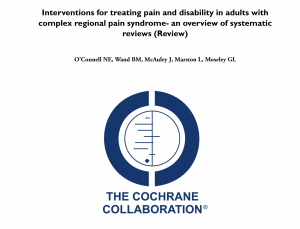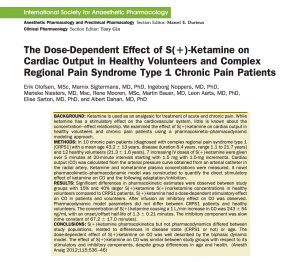CRPS / RSD
What is complex regional pain syndrome?
 Complex regional pain syndrome (CRPS) is a chronic pain condition most often affecting one of the limbs (arms, legs, hands, or feet), usually after an injury or trauma to that limb. CRPS is believed to be caused by damage to, or malfunction of, the peripheral and central nervous systems. The central nervous system is composed of the brain and spinal cord, and the peripheral nervous system involves nerve signaling from the brain and spinal cord to the rest of the body. CRPS is characterized by prolonged or excessive pain and mild or dramatic changes in skin color, temperature, and/or swelling in the affected area.
Complex regional pain syndrome (CRPS) is a chronic pain condition most often affecting one of the limbs (arms, legs, hands, or feet), usually after an injury or trauma to that limb. CRPS is believed to be caused by damage to, or malfunction of, the peripheral and central nervous systems. The central nervous system is composed of the brain and spinal cord, and the peripheral nervous system involves nerve signaling from the brain and spinal cord to the rest of the body. CRPS is characterized by prolonged or excessive pain and mild or dramatic changes in skin color, temperature, and/or swelling in the affected area.
There are two similar forms, called CRPS-I and CRPS-II, with the same symptoms and treatments. CRPS-II (previously called causalgia) is the term used for patients with confirmed nerve injuries. Individuals without confirmed nerve injury are classified as having CRPS-I (previously called reflex sympathetic dystrophy syndrome). Some research has identified evidence of nerve injury in CRPS-I, so the validity of the two different forms is being investigated.
CRPS symptoms vary in severity and duration. Studies of the incidence and prevalence of the disease show that most cases are mild and individuals recover gradually with time. In more severe cases, individuals may not recover and may have long-term disability.
What are the symptoms of CRPS?
The key symptom is prolonged pain that may be constant and, in some people, extremely uncomfortable or severe. The pain may feel like a burning or “pins and needles” sensation, or as if someone is squeezing the affected limb. The pain may spread to include the entire arm or leg, even though the precipitating injury might have been only to a finger or toe. Pain can sometimes even travel to the opposite extremity. There is often increased sensitivity in the affected area, such that even light touch or contact is painful (called allodynia).
People with CRPS also experience constant or intermittent changes in temperature, skin color, and swelling of the affected limb. This is due to abnormal microcirculation caused by damage to the nerves controlling blood flow and temperature. An affected arm or leg may feel warmer or cooler compared to the opposite limb. The skin on the affected limb may change color, becoming blotchy, blue, purple, pale, or red.
Other common features of CRPS include:
- changes in skin texture on the affected area; it may appear shiny and thin
- abnormal sweating pattern in the affected area or surrounding areas
- changes in nail and hair growth patterns
- stiffness in affected joints
- problems coordinating muscle movement, with decreased ability to move the affected body part, and
- abnormal movement in the affected limb, most often fixed abnormal posture (called dystonia) but also tremors in or jerking of the affected limb.
How is CRPS diagnosed?
Currently there is no single diagnostic test to confirm CRPS. Diagnosis is based on the affected individual’s medical history and signs and symptoms that match the definition. But because several other conditions can cause similar symptoms, careful examination is important. Since most people improve gradually over time, diagnosis may be more difficult later in the course of the disorder.
Testing also may be used to help rule out other conditions, such as arthritis syndromes, Lyme disease, generalized muscle diseases, a clotted vein, or small nerve fiber polyneuropathies (such as from diabetes), because these require different treatment. The distinguishing feature of CRPS is usually a history of earlier injury to the affected area, as most of these other conditions are not triggered by injury. Individuals without a history of injury should be carefully examined to make sure that another treatable diagnosis is not missed.
Magnetic resonance imaging or triple-phase bone scans sometimes identify CRPS-characteristic changes in the bone metabolism. CRPS is often associated with excess bone resorption, a process in which certain cells break down the bone and release calcium into the blood.How is CRPS treated?
The following therapies are often used:
Rehabilitation therapy. An exercise program to keep the painful limb or body part moving can improve blood flow and lessen the circulatory symptoms. Additionally, exercise can help improve the affected limb’s flexibility, strength, and function. Rehabilitating the affected limb also can help to prevent or reverse the secondary brain changes that are associated with chronic pain. Occupational therapy can help the individual learn new ways to work and perform daily tasks.
Psychotherapy. CRPS and other painful and disabling conditions often are associated with profound psychological symptoms for affected individuals and their families. People with CRPS may develop depression, anxiety, or post-traumatic stress disorder, all of which heighten the perception of pain and make rehabilitation efforts more difficult. Treating these secondary conditions is important for helping people cope and recover from CRPS.
Medications. Several different classes of medication have been shown to be effective for CRPS, particularly when used early in the course of the disease. No drug is approved by the U.S. Food and Drug Administration specifically for CRPS. No single drug or combination of drugs is guaranteed to be effective in every person. Drugs to treat CRPS include:
- non-steroidal anti-inflammatory drugs to treat moderate pain, including over-the-counter aspirin, ibuprofen, and naproxin
- corticosteroids that treat inflammation/swelling and edema, such as prednisolone and methylprednisolone (used mostly in the early stages of CRPS)
- drugs initially developed to treat seizures or depression but now shown to be effective for neuropathic pain, such as gabapentin, pregabalin, amitriptyline, nortriptyline, and duloxetine
- botulinum toxin injections
- opioids such as oxycontin, morphine, hydrocodone, fentanyl, and vicodin
- N-methyl-D-aspartate (NMDA) receptor antagonists such as dextromethorphan and ketamine
- nasal calcitonin, especially for deep bone pain, and
- topical local anesthetic creams and patches such as lidocaine.
All drugs or combination of drugs can have various side effects such as drowsiness, dizziness, increased heartbeat, and impaired memory. Inform a healthcare professional of any changes once drug therapy begins.
Sympathetic nerve block. Some individuals report temporary pain relief from sympathetic nerve blocks, but there is no published evidence of long-term benefit. Sympathetic blocks involve injecting an anesthetic next to the spine to directly block the activity of sympathetic nerves and improve blood flow.
Surgical sympathectomy. The use of this operation that destroys some of the nerves is controversial. Some experts think it is unwarranted and makes CRPS worse; others report a favorable outcome. Sympathectomy should be used only in individuals whose pain is dramatically relieved (although temporarily) by sympathetic nerve blocks. It also can reduce excess sweating.
Spinal cord stimulation. Placing stimulating electrodes through a needle into the spine near the spinal cord provides a tingling sensation in the painful area. Typically the electrode is placed temporarily for a few days to assess whether stimulation will be helpful. Minor surgery is required to implant all the parts under the skin on the torso. Once implanted, the stimulator can be turned on and off, and adjusted using an external controller. Data shows that about one-fourth of individuals develop equipment problems that may require additional surgeries.
Other types of neural stimulation.Neurostimulation can be delivered at other locations along the pain pathway, not only at the spinal cord. These include near injured nerves (peripheral nerve stimulators), outside the membranes of the brain (motor cortex stimulation with dural electrodes), and within the parts of the brain that control pain (deep brain stimulation). A recent option involves the use of magnetic currents applied externally to the brain (called repetitive Transcranial Magnetic Stimulation, or rTMS). The advantage is that no surgery is required; the disadvantage is need for repeated treatment sessions.
Intrathecal drug pumps. These devices pump pain-relieving medications directly into the fluid that bathes the spinal cord, typically opioids and local anesthetic agents such as clonidine and baclofen. The advantage is that pain-signaling targets in the spinal cord can be reached using doses far lower than those required for oral administration, which decreases side effects and increases drug effectiveness. There are no studies that show benefit specifically for CRPS.
Emerging treatments for CRPS include:
- Intravenous immunoglobulin (IVIG). Researchers in Great Britain reported that low-dose IVIG reduced pain intensity in a small trial of 13 patients with CRPS for 6 to 30 months who did not respond well to other treatments. Those who received IVIG had a greater decrease in pain scores than those receiving saline during the following 14 days after infusion. A larger study involving individuals with acute-phase CRPS is planned.
-
Ketamine. Investigators are using low doses of ketamine—a strong anesthetic—given intravenously for several days to either reduce substantially or eliminate the chronic pain of CRPS. In certain clinical settings, ketamine has been shown to be useful in treating pain that does not respond well to other treatments. Dr. Hanna is the leading provider of IV Ketamine Infusion therapy and has performed many successful treatments.
- Hyperbaric oxygen. Several studies have investigated the use of hyperbaric oxygen therapy for chronic pain. Individuals lie down in a tank containing pressurized air, which delivers more oxygen to the body’s organs and tissues. Although research is still experimental, some researchers report hyperbaric oxygen can reduce swelling and pain, and improve range of motion in individuals with CRPS.
Several alternative therapies have been used to treat other painful conditions. Options include behavior modification, acupuncture, relaxation techniques (such as biofeedback, progressive muscle relaxation, and guided motion therapy), and chiropractic treatment.
Source: NIH National Institute of Neurological Disorders and Stroke
For a detailed research article regarding IV Ketamine Infusion therapy for CRPS/ RSD, click the link below:
Treatment of Complex Regional Pain Syndrome (CRPS) Using Low Dose Naltrexone (LDN)
Patient Testimonials
Lizzy, Dr. Hanna’s patient had been diagnosed with CRPS / RSD in 2013 after a tetanus injection. Her symptoms were so severe, she couldn’t walk and could not perform everyday functions. Dr. Hanna began IV Ketamine treatments for Lizzy and within a few sessions, she was able to walk and is on her way to full remission.
Related Research Articles
Title: Ketamine: a growing global health-care need
Authors: T. T. Dong, J. Mellin-Olsen and A. W. Gelb
Journal: British Journal of Anesthesia
Title: Interventions for treating pain and disability in adults with complex regional pain syndrome- an overview of systematic reviews
Authors: Neil E O’Connell, Benedict M Wand, James McAuley, Louise Marston, G Lorimer Moseley
Journal: Cochrane Database of Systematic Reviews
Title: The Dose-Dependent Effect of S(+)-Ketamine on Cardiac Output in Healthy Volunteers and Complex Regional Pain Syndrome Type 1 Chronic Pain Patients
Authors: Olofsen, Erik MSc; Sigtermans, Marnix MD, PhD; Noppers, Ingeborg MD, PhD; Niesters, Marieke MD, Msc; Mooren, Rene MSc; Bauer, Martin MD; Aarts, Leon MD, PhD; Sarton, Elise MD, PhD; Dahan, Albert MD, PhD
Journal: Anesthesia & Analgesia



